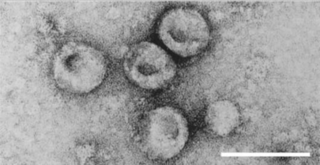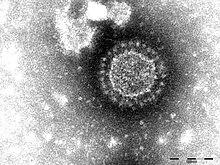
A pig is any of the animals in the genus Sus, within the even-toed ungulate family Suidae. Pigs include domestic pigs and their ancestor, the common Eurasian wild boar, along with other species. Pigs, like all suids, are native to the Eurasian and African continents, ranging from Europe to the Pacific islands. Suids other than the pig are the babirusa of Indonesia, the pygmy hog of South Asia, the warthog of Africa, and another genus of pigs from Africa. The suids are a sister clade to peccaries.
Classical swine fever (CSF) or hog cholera is a highly contagious disease of swine. It is mentioned as a potential bioweapon.

Swine influenza is an infection caused by any one of several types of swine influenza viruses. Swine influenza virus (SIV) or swine-origin influenza virus (S-OIV) is any strain of the influenza family of viruses that is endemic in pigs. As of 2009, the known SIV strains include influenza C and the subtypes of influenza A known as H1N1, H1N2, H2N1, H3N1, H3N2, and H2N3.
Porcine circoviral disease (PCVD) and porcine circovirus associated disease (PCVAD), is a disease seen in domestic pigs. This disease causes illness in piglets, with clinical signs including progressive loss of body condition, visibly enlarged lymph nodes, difficulty in breathing, and sometimes diarrhea, pale skin, and jaundice. PCVD is very damaging to the pig-producing industry and has been reported worldwide. PCVD is caused by Porcine circovirus 2 (PCV-2).
Betaarterivirus suid 1, formerly Porcine reproductive and respiratory syndrome virus (PRRSV), is a virus that causes a disease of pigs, called porcine reproductive and respiratory syndrome (PRRS), also known as blue-ear pig disease. This economically important, panzootic disease causes reproductive failure in breeding stock and respiratory tract illness in young pigs. Initially referred to as "mystery swine disease" and "mystery reproductive syndrome", it was first reported in 1987 in North America (2) and Central Europe (3). The disease costs the United States swine industry around $644 million annually, and recent estimates in Europe found that it costs almost 1.5b€ every year.

Pestivirus is a genus of viruses, in the family Flaviviridae. Viruses in the genus Pestivirus infect mammals, including members of the family Bovidae and the family Suidae. Currently, 11 species are placed in this genus, including the type species Pestivirus A. Diseases associated with this genus include: hemorrhagic syndromes, abortion, and fatal mucosal disease.
Porcine parvovirus (PPV), a virus in the species Ungulate protoparvovirus 1 of genus Protoparvovirus in the virus family Parvoviridae, causes reproductive failure of swine characterized by embryonic and fetal infection and death, usually in the absence of outward maternal clinical signs. The disease develops mainly when seronegative dams are exposed oronasally to the virus anytime during about the first half of gestation, and conceptuses are subsequently infected transplacentally before they become immunocompetent. There is no definitive evidence that infection of swine other than during gestation is of any clinical or economic significance. The virus is ubiquitous among swine throughout the world and is enzootic in most herds that have been tested. Diagnostic surveys have indicated that PPV is the major infectious cause of embryonic and fetal death. In addition to its direct causal role in reproductive failure, PPV can potentiate the effects of porcine circovirus type II (PCV2) infection in the clinical course of postweaning multisystemic wasting syndrome (PMWS).
Aujeszky's disease, usually called pseudorabies in the United States, is a viral disease in swine that has been endemic in most parts of the world. It is caused by Suid herpesvirus 1 (SuHV-1). Aujeszky's disease is considered to be the most economically important viral disease of swine in areas where classical swine fever has been eradicated. Other mammals, such as cattle, sheep, goats, cats, dogs, and raccoons, are also susceptible. The disease is usually fatal in these animal species.

African swine fever virus (ASFV) is a large, double-stranded DNA virus in the Asfarviridae family. It is the causative agent of African swine fever (ASF). The virus causes a hemorrhagic fever with high mortality rates in domestic pigs; some isolates can cause death of animals as quickly as a week after infection. It persistently infects its natural hosts, warthogs, bushpigs, and soft ticks of the genus Ornithodoros, which likely act as a vector, with no disease signs. It does not cause disease in humans. ASFV is endemic to sub-Saharan Africa and exists in the wild through a cycle of infection between ticks and wild pigs, bushpigs, and warthogs. The disease was first described after European settlers brought pigs into areas endemic with ASFV, and as such, is an example of an emerging infectious disease.

Pig farming or hog farming is the raising and breeding of domestic pigs as livestock, and is a branch of animal husbandry. Pigs are farmed principally for food and skins.

Foot-and-mouth disease (FMD) or hoof-and-mouth disease (HMD) is an infectious and sometimes fatal viral disease that affects cloven-hoofed animals, including domestic and wild bovids. The virus causes a high fever lasting two to six days, followed by blisters inside the mouth and on the feet that may rupture and cause lameness.
Vesicular exanthema of swine virus (VESV) is a virus which produces a disease in pigs that is clinically indistinguishable from the viruses causing foot-and-mouth disease (FMD) and swine vesicular disease (SVD). VESV affects only pigs and marine mammals. It is not transmissible to humans.
Blue eye disease is caused by La Piedad Michoacán Mexico virus (LPMV), the only member virus of the species Porcine orthorubulavirus in the Paramyxoviridae family. Synonyms for the disease include "Blue Eye Syndrome" and "Porcine Paramyxovirus Blue Eye Disease", and "La Piedad Michoacán Paramyxovirus Infection".
Porcine epidemic diarrhea is a condition caused by the porcine epidemic diarrhea virus that leads to severe gastrointestinal disease in pigs.

Coronavirus HKU15, sometimes called Porcine coronavirus HKU15 is a virus first discovered in a surveillance study in Hong Kong, China, and first reported to be associated with porcine diarrhea in February 2014. In February 2014, PorCoV HKU15 was identified in pigs with clinical diarrhea disease in the U.S. state of Ohio. The complete genome of one US strain has been published. Since then, it has been identified in pig farms in Canada. The virus has been referred to as Porcine coronavirus HKU15, Swine deltacoronavirus and Porcine deltacoronavirus.
Suipoxvirus is a genus of viruses, in the family Poxviridae, in the subfamily Chordopoxvirinae. Swine serve as natural hosts. There is currently only one species in this genus: the type species Swinepox virus. Diseases associated with this genus include: asymptomatic skin disease.

James E. Collins is an American veterinary physician and academic. He is the professor of medicine at the University of Minnesota and its Director of the veterinary diagnostic laboratory.
Xiang-Jin Meng, also known as X.J. Meng, is a Chinese-born American virologist. He is a University Distinguished Professor at Virginia Tech. He studies emerging, re-emerging and zoonotic viruses of veterinary and human public health significance. He was elected a member of the National Academy of Sciences in 2016, a Fellow of the National Academy of Inventors in 2014, and a Fellow of the American Academy of Microbiology in 2012.

The history of coronaviruses is a reflection of the discovery of the diseases caused by coronaviruses and identification of the viruses. It starts with the first report of a new type of upper-respiratory tract disease among chickens in North Dakota, US, in 1931. The causative agent was identified as a virus in 1933. By 1936, the disease and the virus were recognised as unique from other viral disease. The became known as infectious bronchitis virus (IBV), but later officially renamed as Avian coronavirus.

Alphacoronavirus 1 is a species of coronavirus that infects cats, dogs and pigs. It includes species earlier described as Feline coronavirus, Canine coronavirus and Transmissible gastroenteritis virus. It is an enveloped, positive-sense, single-stranded RNA virus and able to enter its host cell by binding to the APN receptor.











